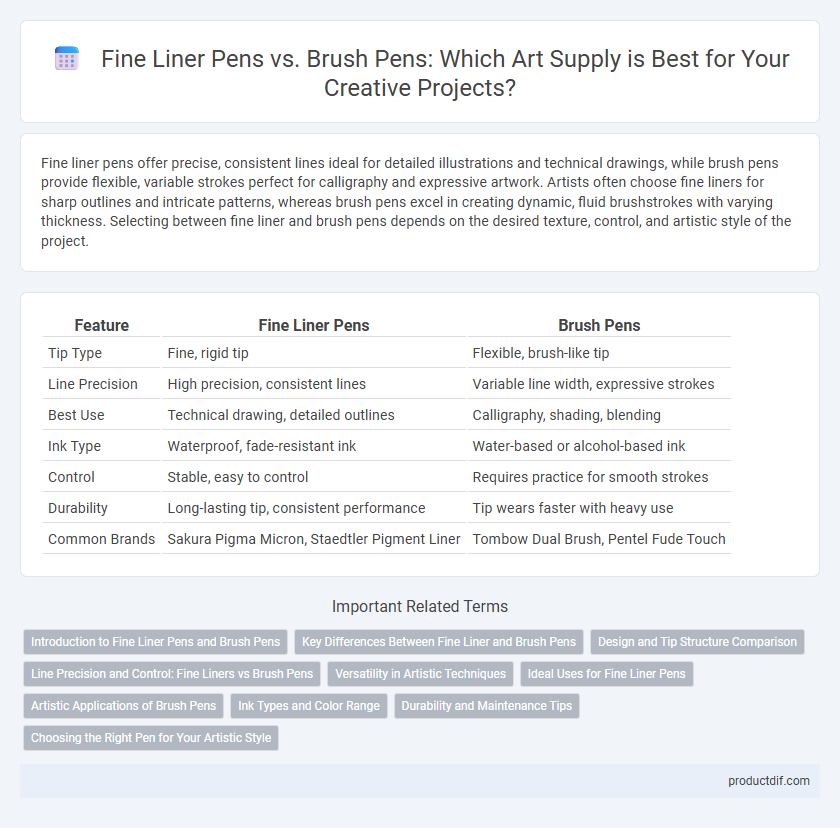Fine liner pens offer precise, consistent lines ideal for detailed illustrations and technical drawings, while brush pens provide flexible, variable strokes perfect for calligraphy and expressive artwork. Artists often choose fine liners for sharp outlines and intricate patterns, whereas brush pens excel in creating dynamic, fluid brushstrokes with varying thickness. Selecting between fine liner and brush pens depends on the desired texture, control, and artistic style of the project.
Table of Comparison
| Feature | Fine Liner Pens | Brush Pens |
|---|---|---|
| Tip Type | Fine, rigid tip | Flexible, brush-like tip |
| Line Precision | High precision, consistent lines | Variable line width, expressive strokes |
| Best Use | Technical drawing, detailed outlines | Calligraphy, shading, blending |
| Ink Type | Waterproof, fade-resistant ink | Water-based or alcohol-based ink |
| Control | Stable, easy to control | Requires practice for smooth strokes |
| Durability | Long-lasting tip, consistent performance | Tip wears faster with heavy use |
| Common Brands | Sakura Pigma Micron, Staedtler Pigment Liner | Tombow Dual Brush, Pentel Fude Touch |
Introduction to Fine Liner Pens and Brush Pens
Fine liner pens feature precise, consistent tips ideal for detailed line work and technical drawings, commonly used in architecture, illustration, and graphic design. Brush pens offer flexible, variable-width tips that mimic traditional brushes, perfect for calligraphy, sketching, and expressive artwork. Both tools serve distinct artistic purposes, with fine liners excelling in precision and brush pens in dynamic stroke variation.
Key Differences Between Fine Liner and Brush Pens
Fine liner pens offer precise, consistent lines ideal for detailed technical drawings and intricate illustrations, while brush pens feature flexible tips that enable variable line widths and expressive strokes suited for calligraphy and dynamic artwork. Fine liners typically use water-resistant, archival-quality ink that resists smudging, whereas brush pens often contain water-based or pigment inks that blend well for watercolor effects. The choice between fine liner and brush pens depends on the desired control, line variation, and artistic technique in projects such as graphic design, sketching, or lettering.
Design and Tip Structure Comparison
Fine liner pens feature rigid, precise tips ranging from 0.03mm to 0.8mm, ideal for detailed line work and consistent strokes in technical drawing and graphic design. Brush pens have flexible, tapered bristles or felt tips that mimic traditional brush strokes, allowing for dynamic line variation and expressive lettering in calligraphy and illustration. The structural difference impacts control and versatility: fine liners excel in precision, while brush pens offer fluidity and organic texture.
Line Precision and Control: Fine Liners vs Brush Pens
Fine liner pens offer exceptional line precision and control, making them ideal for detailed drawings, technical sketches, and intricate patterns with consistent, sharp lines. Brush pens provide variable line width through pressure sensitivity, allowing artists to create expressive strokes and dynamic line variation but require more skill to manage smoothness and precision. For artists prioritizing exactness and uniformity, fine liners deliver superior control, whereas brush pens excel in fluidity and artistic expression.
Versatility in Artistic Techniques
Fine liner pens offer precise control for detailed line work, technical drawings, and intricate patterns, making them ideal for artists who prioritize accuracy. Brush pens excel in creating dynamic strokes, varied line widths, and smooth shading, enabling fluid expression in calligraphy, illustration, and watercolor effects. Both tools complement each other by enhancing versatility in artistic techniques through their distinct applications and tactile qualities.
Ideal Uses for Fine Liner Pens
Fine liner pens are ideal for precise line work, detailed illustrations, and technical drawings due to their consistent, fine tips that provide sharp, controlled lines. They excel in creating intricate patterns, architectural sketches, and text outlines where accuracy and clarity are essential. Artists and designers rely on fine liners for tasks requiring steady, uniform strokes and crisp edges.
Artistic Applications of Brush Pens
Brush pens provide artists with versatile stroke control, allowing for dynamic line variation that mimics traditional brushes, ideal for calligraphy, illustration, and detailed shading. Their flexible tips enable smooth blending and layering of colors, enhancing depth and texture in artworks. Preferred in manga and watercolor techniques, brush pens offer precision and fluidity, making them essential for expressive and intricate artistic applications.
Ink Types and Color Range
Fine liner pens typically use water-based or pigment ink that offers precise, consistent lines and fast drying times, ideal for detailed work and technical drawings. Brush pens feature dye-based or pigment ink with flexible tips that provide varying line widths and rich, vibrant colors, suitable for calligraphy and expressive artwork. The color range of brush pens generally surpasses that of fine liners, offering extensive hues and blending capabilities.
Durability and Maintenance Tips
Fine liner pens offer superior durability with their sturdy metal tips designed for consistent, precise lines, making them ideal for detailed work and extended use. Brush pens require careful maintenance to prevent fraying of synthetic or natural bristles, including regular cleaning and proper capping after use to maintain ink flow and tip flexibility. Choosing between fine liner and brush pens depends on prioritizing long-lasting precision or dynamic stroke variations, with upkeep routines tailored to preserve each pen's functional longevity.
Choosing the Right Pen for Your Artistic Style
Fine liner pens provide precision and control, ideal for detailed line work and intricate designs in technical drawings or lettering. Brush pens offer dynamic line variation and fluid strokes, perfect for expressive illustrations and calligraphy that emphasize texture and movement. Selecting the right pen depends on your artistic style--fine liners suit structured, precise art while brush pens enhance fluid, organic creativity.
Fine liner pens vs Brush pens Infographic

 productdif.com
productdif.com